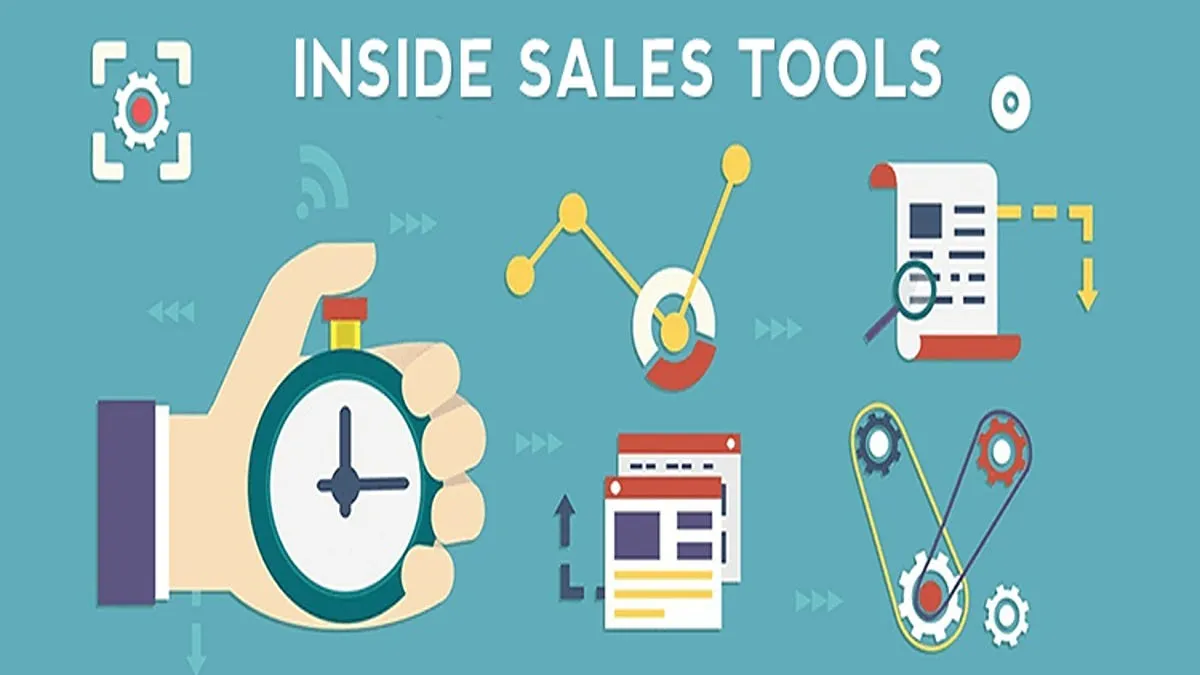What is Inside Sales

Inside sales refers to the selling of products or services by personnel who reach customers through phone calls, email, or the internet, rather than visiting customers in person.
Typically, inside sales operations are conducted from a company's office and increasingly rely on sophisticated software to reach out to potential customers. This model contrasts with outside sales, where sales representatives meet with clients in person.
Key Characteristics:
- Remote Interaction: Unlike traditional face-to-face sales, inside sales reps work from a central location using telecommunication to engage with customers.
- Technology-Driven: Modern inside sales teams utilize CRM software, auto dialers, and sales automation tools to enhance efficiency.
- Cost-Effectiveness: Operating costs for inside sales are often lower compared to outside sales since travel expenses are minimal.
Advantages of Inside Sales
Inside sales offers several distinct advantages that make it an attractive strategy for many businesses, especially in B2B and tech industries.
1. Reduced Costs
Inside sales can significantly reduce the cost of sales by eliminating travel and related expenses. For instance, companies report up to 40-90% savings on travel and entertainment costs by switching to inside sales models.
2. Increased Reach and Scalability
Broader Geographical Reach: Sales reps can contact far more prospects over the phone or online than they could by in-person visits. This expands the potential customer base without geographical boundaries.
Scalability: It's easier and more cost-effective to scale an inside sales team as business needs grow, compared to hiring additional outside sales personnel.
3. Enhanced Efficiency and Productivity
Faster Sales Cycles: Inside sales typically has shorter sales cycles due to the speed of direct and electronic communications. Research shows that inside sales can shorten the sales cycle by 20-50% compared to outside sales.
Data-Driven Decisions: With advanced analytics tools, inside sales teams can better track performance and outcomes, leading to more informed decision-making and strategy adjustments.
4. Improved Customer Data Management
Better Lead Management: CRM systems enable inside sales reps to better manage customer information, track interactions, and follow up efficiently. Statistics show that using CRM can increase sales by up to 29%.
Personalized Customer Interactions: Automated tools allow reps to personalize their communications at scale, potentially increasing conversion rates.
How Does Inside Sales Work

Inside sales is a strategic approach where sales representatives reach and engage with potential customers primarily via phone, email, or other online communication tools, rather than in-person meetings. Here’s how the process typically works, broken down into clear, step-by-step stages:
1. Lead Generation
- Initial Contact: The process begins with identifying potential customers or leads. This can involve various tactics such as inbound marketing, social media engagement, or utilizing lead databases.
- Qualification: Leads are then assessed through criteria such as need, budget, authority, and timeline to determine if they are qualified prospects.
2. Lead Nurturing
- Regular Communication: Sales reps engage with these qualified leads by providing information, answering questions, and building relationships through regular emails, calls, and virtual meetings.
- Education and Value Proposition: The reps educate leads on how their product or service can solve specific problems or improve business outcomes, effectively communicating the value proposition.
3. Sales Pitch/Presentation
- Customized Demos: Based on the gathered insights about the lead’s needs and preferences, customized demonstrations or presentations of the product or service are conducted, usually through online meeting platforms.
- Feature Highlighting: Key features and benefits tailored to the lead’s specific needs are highlighted to reinforce the value and uniqueness of the offer.
4. Handling Objections
- Address Concerns: In this stage, inside sales reps handle any objections or reservations the leads might have. This requires deep product knowledge and an understanding of the lead's industry and challenges.
- Clarification and Reassurance: Reps clarify any misunderstandings and provide reassurance by presenting case studies, testimonials, or data points that support the effectiveness of their solution.
5. Closing the Sale
- Negotiation: Terms of the sale such as price, delivery, and any custom requirements are negotiated.
- Final Agreement: Once terms are agreed upon, contracts or agreements are signed, often digitally, to finalize the sale.
6. Post-Sale Follow-Up
- Customer Success: After closing the sale, inside sales teams often work with customer success to ensure that the customer is satisfied and fully utilizes the product or service.
- Upselling and Cross-Selling: Ongoing relationships are maintained to explore further sales opportunities, such as upselling additional features or cross-selling related products.
7. Data Analysis and Refinement
- Performance Tracking: Sales activities and outcomes are tracked using CRM software and other analytics tools.
- Continuous Improvement: Insights gained from data analysis are used to refine strategies, improve sales pitches, and enhance lead generation and nurturing processes.
Inside Sales Tools

Inside sales teams rely heavily on various tools to streamline processes, enhance productivity, and improve customer interactions.
These tools not only help in managing day-to-day activities but also provide critical data that aids in decision-making and strategy refinement. Here’s an overview of the essential types of tools used in inside sales:
1. Customer Relationship Management (CRM) Software
Purpose: CRMs are the backbone of any inside sales operation. They store all customer data in one place, track every interaction, and automate various tasks related to the sales process.
Examples: Salesforce, HubSpot, and Zoho CRM are popular choices that offer extensive features for lead management, sales automation, and analytics.
2. Communication Tools
Purpose: Efficient communication is crucial for inside sales. Tools that facilitate seamless communication via phone, email, or video help maintain a personal touch.
Examples:
- Email: Tools like Outreach and Mailchimp allow for automated email campaigns and follow-ups.
- Calling: Software like RingCentral and Aircall offer cloud-based calling systems with features like call logging, recording, and analytics.
- Video Conferencing: Zoom and Microsoft Teams are essential for conducting face-to-face meetings virtually.
3. Sales Engagement Platforms
Purpose: These platforms help sales teams automate and synchronize outreach across multiple channels like email, social media, and phone.
Examples: Salesloft and Outreach.io provide workflows that ensure consistent communication, allowing reps to focus more on selling rather than on administrative tasks.
4. Sales Enablement Tools
Purpose: These tools ensure that sales reps have the right materials at the right time, from pitch decks to white papers, improving the sales process's effectiveness.
Examples: Highspot and Seismic help organize content, optimize its usage, and provide analytics on content performance.
5. Lead Generation and Prospecting Tools
Purpose: Finding and gathering information about potential leads is fundamental for inside sales.
Examples: LinkedIn Sales Navigator offers advanced search capabilities and personalized insights on leads. Leadfeeder tracks companies visiting your website, helping identify warm leads.
6. Productivity and Automation Tools
Purpose: Automating repetitive tasks frees up time for sales reps to focus on engaging with clients.
Examples: Zapier can connect different apps and automate workflows. Calendly automates scheduling by allowing prospects to book meetings directly into a rep’s calendar.
7. Analytics and Reporting Tools
Purpose: Understanding sales performance and identifying areas for improvement is crucial for scaling operations.
Examples: Tableau and Google Analytics provide deep insights into sales activities and outcomes, helping teams make data-driven decisions.
8. Contract and Document Management
Purpose: Managing the documentation involved in sales processes digitally to ensure efficiency and reduce manual errors.
Examples: DocuSign and Adobe Sign facilitate electronic signatures, while tools like PandaDoc help manage sales proposals and contracts seamlessly.
What Does an Inside Sales Representative Do

This role involves several key responsibilities and activities that contribute to the success and efficiency of the sales process. Here’s a detailed look at what an Inside Sales Representative typically does:
Lead Management
- Lead Generation: Utilize various sources like social media, company databases, and inbound marketing strategies to generate new leads.
- Lead Qualification: Evaluate the potential of leads based on specific criteria such as their need, budget, timeline, and decision-making authority to ensure they are worth pursuing.
Communication and Engagement
- Initial Contact: Reach out to potential clients through emails, phone calls, or online platforms to introduce the company and its offerings.
- Relationship Building: Develop and maintain relationships with prospects and existing customers, often involving regular follow-ups and personalized communication to nurture leads through the sales funnel.
Sales Pitch and Demonstrations
- Product Presentation: Conduct detailed product or service demonstrations, often via video calls or web presentations, tailored to address the specific needs and pain points of each prospect.
- Handling Objections: Address any concerns or objections raised by prospects with informed responses and reassurance, showcasing the value and benefits of the solutions offered.
Closing Sales
- Negotiation: Engage in negotiations regarding pricing, terms, and conditions of sales, aiming to reach a mutually beneficial agreement.
- Sales Conversion: Close deals by finalizing sales contracts and ensuring that all parties are clear about the terms of the sale.
Post-Sale Support
- Customer Onboarding: Assist new customers in getting started with the product or service, ensuring they understand how to use it effectively.
- Follow-Up: Maintain contact with customers to ensure satisfaction, resolve any issues, and identify opportunities for upselling or cross-selling additional products or services.
Collaboration and Reporting
- Team Collaboration: Work closely with other sales and marketing team members to align strategies and exchange information about customer needs and market trends.
- Performance Tracking: Keep accurate records of sales activities, leads, and customer interactions in CRM systems to track performance against sales targets.
Continuous Learning and Improvement
- Product Knowledge: Continuously update knowledge about the products or services being sold to effectively communicate benefits and updates to customers.
- Skill Development: Participate in training and professional development opportunities to enhance sales techniques and stay updated on industry trends.
Role Specialization
Depending on the company and industry, Inside Sales Representatives may also specialize in particular areas, such as:
- Technical Sales: Focusing on selling complex technological products or services, requiring deeper technical knowledge.
- Account Management: Managing key accounts and focusing on growing and retaining existing clients.
- Lead Specialist: Concentrating on top-of-the-funnel activities like lead generation and initial contact, especially in larger sales teams.
Inside Sales vs Outside Sales
Key Concepts of Inside Sales
Inside sales, a critical component of modern sales strategies, especially in B2B (business to business) markets, encompasses several key concepts that distinguish it from traditional sales models. Here are the primary concepts that underpin inside sales:
Remote Sales Activities
Unlike outside sales, where outside sales reps often travel to meet clients, inside sales activities are conducted remotely from an office or home setting. Representatives use digital communication tools like phones, email, and video conferencing to engage with prospective customers, negating the need for physical travel.
High-Volume Outreach
Inside sales teams typically handle a higher volume of leads and customer interactions compared to outside sales due to the efficiency of remote communication. This approach allows for more touches in less time, facilitating a faster sales cycle.
Leveraging Technology
Technology is at the core of inside sales. Key tools include:
- Customer Relationship Management (CRM) Systems: These are essential for tracking interactions, managing customer data, and automating sales activities.
- Automated Dialers: To increase call volume and efficiency.
- Email Automation Tools: For sending bulk emails that are personalized to each recipient.
- Video Conferencing Platforms: To conduct product demos and meetings, often referred to as virtual sales.
Focus on Sales Metrics and Analytics
Inside sales is heavily driven by metrics and analytics. Sales leaders rely on data to measure everything from call duration and conversion rates to email open rates and lead progression through the sales funnel. This data-centric approach helps optimize processes and strategies for better outcomes.
Structured Sales Process
The sales process in an inside sales setting is usually highly structured, involving clearly defined stages from lead generation and qualification to nurturing, presentation, closing, and post-sale follow-up. Each stage has specific goals and KPIs associated with it, reflecting a deliberate sales strategy.
Team Collaboration
Inside sales often requires a coordinated effort between various team members, including sales development reps (SDRs), account executives (AEs), and customer success managers. Collaboration tools and regular strategy meetings ensure that everyone is aligned and working effectively towards common goals.
Skill Set Requirements
The skill set for inside sales reps is slightly different from that required for field sales. Key skills include:
- Excellent Communication Skills: Both written and verbal, tailored to digital mediums.
- Technical Proficiency: Understanding and managing sales tech stacks.
- Adaptability: Quickly adapting strategies based on customer feedback and market conditions.
Scalability
Inside sales models are inherently scalable. They allow businesses to quickly expand their sales operations without a proportional increase in costs. This scalability is facilitated by digital tools and software that can easily accommodate an increasing number of sales interactions.
Customer Segmentation and Personalization
Effective inside sales strategies often involve a high degree of customer segmentation and personalized communication. This targeted approach ensures that potential customers receive messages tailored to their specific needs and stages in the buyer’s journey, increasing the likelihood of conversion.
How Inside Sales Reps Operate in B2B vs. B2C
Inside sales representatives play a pivotal role in both B2B (business to business) and B2C (business to consumer) environments.
Although the overarching goal in both sectors is to drive sales and enhance revenue, the operational nuances, strategies, and interactions differ significantly based on the nature of the target audience and the sales process itself.
Here’s an in-depth look at how inside sales reps operate in B2B versus B2C contexts:
B2B Inside Sales Operations
Complex Decision-Making Process
- Multiple Stakeholders: B2B transactions typically involve multiple decision-makers or influencers within an organization. Inside sales reps need to identify and engage various stakeholders, tailoring their pitch to address the specific concerns and interests of each group.
- Longer Sales Cycles: The sales cycle in B2B can range from a few months to over a year due to the need for detailed product demonstrations, negotiations, and approval processes.
Highly Customized Solutions
- Tailored Products/Services: B2B products or services are often complex and may require customization to meet the specific needs of a business. Inside sales reps must have a deep understanding of their offerings to effectively communicate potential configurations and modifications.
- Consultative Selling Approach: Reps act as consultants, advising clients on the best solutions to solve their specific problems, which requires a thorough understanding of both their own product’s capabilities and the client’s industry.
Value-Based Selling
- ROI Focus: In B2B sales, demonstrating the return on investment (ROI) is crucial. Inside sales reps must be able to explain how their product or service can reduce costs, increase efficiency, or otherwise positively impact the client’s bottom line.
- Relationship Building: Developing long-term relationships is critical in B2B sales. Reps need to maintain contact, provide ongoing support, and continually assess the client’s evolving needs to secure repeat business and referrals.
B2C Inside Sales Operations
High-Volume, Short Sales Cycles
- Immediate Transactions: B2C sales cycles are typically much shorter, often concluding in a single call or interaction. Inside sales reps need to be effective at quickly building rapport and closing sales in a limited time.
- Impulse Buying: B2C customers are more likely to make impulse purchases based on emotion rather than extensive research. Reps must be adept at creating a sense of urgency and appealing to emotional triggers.
Product Familiarity and Accessibility
- Simpler Products/Services: In B2C, the products or services are usually less complex than those in B2B. This simplicity allows reps to focus more on benefits and features that are easily understood and appreciated by the average consumer.
- Wider Audience: B2C inside sales reps often deal with a much broader audience, requiring a communication style that is more universal and less jargon-heavy.
Consumer-Focused Selling
- Personal Benefits: The selling approach in B2C focuses more on the personal benefit to the consumer, such as convenience, status enhancement, or pleasure.
- Quick Resolution and Follow-Up: B2C reps need to be quick in resolving queries and issues to enhance customer satisfaction and encourage repeat business.
Tools and Techniques
Technology Utilization
- Both B2B and B2C inside sales reps rely heavily on CRM systems to manage customer interactions, but the type of data tracked can vary. B2B reps might focus more on company-related data, whereas B2C reps track individual consumer behaviors.
- Automated tools for email marketing, lead nurturing, and follow-ups are commonly used in both sectors, though the messaging and frequency may differ.
Training and Skills Development
- Training for B2B reps often includes deep dives into industry-specific knowledge, while B2C training might focus more on customer service skills and handling high call volumes.
Concluding Thoughts for Both Inside and Outside Sales
Inside sales represents a transformative approach for modern businesses, leveraging technology to efficiently reach and engage customers. Unlike outside sales, where sales rep meet clients in person, inside sales reps conduct their activities remotely, resulting in cost savings, broader reach, and enhanced productivity. This method proves especially advantageous in B2B settings with complex decision-making processes, as well as in B2C environments requiring high-volume, quick transactions. By understanding and implementing the key concepts and tools of inside sales, businesses can significantly improve their sales strategies and outcomes, ensuring sustained growth and customer satisfaction.





.jpg)

.jpg)
